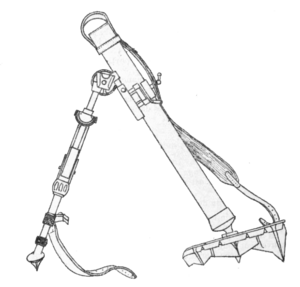| Brandt Mle 1935 | |
|---|---|
 Side view of the Brandt Mle 1935 Side view of the Brandt Mle 1935 | |
| Type | Mortar |
| Place of origin | France |
| Service history | |
| Wars | World War II Second Sino-Japanese War Chinese Civil War First Indochina War Algerian War Vietnam War Laotian Civil War Cambodian Civil War Portuguese Colonial War |
| Production history | |
| Designer | Edgar Brandt |
| No. built | Over 4,900 (before 1940) |
| Variants | Brandt Mle 1935 modifié 1944 |
| Specifications | |
| Mass | 19.7 kg (43 lb 7 oz) |
| Barrel length | 72.4 cm (2 ft 5 in) |
| Crew | 5 |
| Cartridge | Light HE shell: 1.3 kg (2 lb 14 oz) Heavy HE shell: 2.2 kg (4 lb 14 oz) |
| Caliber | 60.7 mm (2.39 in) |
| Rate of fire | 20-26 rounds per minute |
| Muzzle velocity | 158 m/s (520 ft/s) |
| Effective firing range | Light HE shell: 100 m (330 ft) to 1.7 km (1.1 mi) Heavy HE shell: 100 m (330 ft) to .95 km (0.59 mi) |
| Filling weight | Light HE shell: 160 g (5.6 oz) |
The Brandt Mle 1935 60-mm mortar (French: Mortier de 60 mm Mle 1935) was a company-level indirect-fire weapon of the French army during the Second World War. Designed by Edgar Brandt, it was copied by other countries, such as the United States and China, as well as purchased and built by Romania. Modified in 1944, the mortar continued to be used by France after the war until at least the 1960s.
Description
The Brandt Mle 1935 was a simple and effective weapon, consisting of a smoothbore metal tube fixed to a base plate (to absorb recoil), with a lightweight bipod mount. The team of the Mle 1935 was made of five men: a leader, a firer, an artificer and two suppliers. When a mortar bomb was dropped into the tube, an impact-sensitive primer in the base of the bomb would make contact with a firing pin at the base of the tube, and detonate, igniting a gunpowder charge, which would propel the bomb out of the tube, and towards the target.
HE mortar bombs fired by the weapon weighed 1.33 kilograms. A French infantry company in 1940 was allocated one Mle 1935 mortar.
This weapon provided a pattern for other light mortars used during World War II. Among the best known is the U.S. 60-mm M2 mortar. Captured examples were used by the Germans as the 6 cm Granatwerfer 225(f).

Romania also purchased and license-built the Mle 1935 mortar prior to and during the Second World War. The mortars were produced at the Voina Works in Brașov, with a production rate of 26 pieces per month as of October 1942.
Users
 France
France United States
United States Nazi Germany
Nazi Germany Portugal
Portugal Kingdom of Romania
Kingdom of Romania Republic of China
Republic of China Cambodia
Cambodia Kingdom of Laos
Kingdom of Laos North Vietnam
North Vietnam
See also
Notes
- Ezell, Edward Clinton (1988). Personal firepower. The Illustrated history of the Vietnam War 15. Bantam Books. p. 41. ISBN 978-0-553-34549-0. OCLC 1036801376.
- Huon, Jean (March 1992). "L'armement français en A.F.N." Gazette des Armes (in French). No. 220. pp. 12–16.
- Rottman, Gordon L. (10 Feb 2009). North Vietnamese Army Soldier 1958–75. Warrior 135. Osprey Publishing. p. 32. ISBN 9781846033711.
- ^ Chamberlain, Peter (1975). Mortars and rockets. Gander, Terry. New York: Arco Pub. Co. p. 4. ISBN 0668038179. OCLC 2067459.
- French manual cover page image
- Manuel du gradé 1939, p. 283.
- Manuel du gradé 1939, p. 448.
- Manuel du gradé 1939, p. 288.
- Manuel du gradé 1939, p. 292.
- Manuel du gradé 1939, p. 498(32).
- lexicon-der-wehrmacht.de
- Axworthy 1995, p. 29.
- Great Britain. Foreign Office, Ministry of Economic Warfare, 1944, Rumania Basic Handbook, p. 27
- Axworthy 1995, p. 75.
References
- Axworthy, Mark (1995). Third Axis Fourth Ally. London: Arms and Armour Press. ISBN 9781854092670.
- Ferrard, Stéphane. Les mortier Brandt de 60 et 81 mm dans l'Armée française en 1940.
- Ministère de la guerre. Direction de l'infanterie (1939). "Mortier de 60". Manuel du gradé d'infanterie. Vol. VIII - Chapter VI. Charles-Lavauzelle. pp. 283–307.
External links
| French infantry weapons of World War II (1939–1940) | |
|---|---|
| Sidearms | |
| Rifles and carbines | |
| Submachine guns | |
| Machine guns and other larger weapons | |
| Mortars | |
| Grenades | |
| Cartridges used by France during World War II | |
This article relating to artillery is a stub. You can help Misplaced Pages by expanding it. |